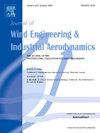Analysis of wind-induced vibration and collapse failure of prestressed truss string structures under thunderstorm downbursts
IF 4.9
2区 工程技术
Q1 ENGINEERING, CIVIL
Journal of Wind Engineering and Industrial Aerodynamics
Pub Date : 2025-06-11
DOI:10.1016/j.jweia.2025.106146
引用次数: 0
Abstract
A deterministic-stochastic hybrid model is employed to simulate the thunderstorm downburst wind field on prestressed truss string structures (PTSS). Subsequently, machine learning techniques are utilized to predict the wind pressure coefficients (WPCs) of the structure under such downbursts, which indicate that the XGBoost model demonstrates superior predictive performance, achieving the R2 of 0.9921. Based on the wind field simulations and WPC predictions, the wind-induced vibration response of the PTSS is analyzed. The results show that yielding of diagonal web members leads to significant residual deformation, while cables experience tension relaxation, with up to 56 % loss. Subsequent incremental dynamic analysis (IDA) quantitatively investigated the progressive deformation patterns and the wind-driven collapse mechanism. As the downburst wind speed approaches its peak, stress conditions of the top and bottom chords undergo a sudden change. Notably, significant mid-span deformation occurs in the bottom chord on the windward side, leading to bulging and sinking areas. The stress conditions of diagonal web members undergo a secondary abrupt change leading to buckling, increasing buckling degrees among related members. Such changes cause substantial rotations within one-third span of truss on the windward side, culminating in dynamic structural collapse, which indicates the high sensitivity of PTSS under thunderstorm downbursts.
雷暴下突下预应力桁架弦结构的风致振动及倒塌破坏分析
采用确定性-随机混合模型对预应力桁架弦结构的雷暴降暴风场进行了数值模拟。随后,利用机器学习技术预测下爆下结构的风压系数(WPCs),结果表明,XGBoost模型具有较好的预测性能,R2为0.9921。基于风场模拟和WPC预测,分析了PTSS的风致振动响应。结果表明:斜向腹板构件的屈服导致了显著的残余变形,而索则出现了张拉松弛,损失高达56%;随后的增量动力分析(IDA)定量研究了渐进式变形模式和风致坍塌机制。当下突风速接近峰值时,上下和弦的应力状况发生突然变化。值得注意的是,下弦在迎风侧发生了明显的跨中变形,导致鼓形和下沉区域。斜腹板受力情况发生二次突变导致屈曲,相关构件屈曲程度增大。这种变化引起迎风侧桁架三分之一跨度内的剧烈旋转,最终导致结构的动态坍塌,这表明PTSS在雷暴下突下具有很高的灵敏度。
本文章由计算机程序翻译,如有差异,请以英文原文为准。
求助全文
约1分钟内获得全文
求助全文
来源期刊
CiteScore
8.90
自引率
22.90%
发文量
306
审稿时长
4.4 months
期刊介绍:
The objective of the journal is to provide a means for the publication and interchange of information, on an international basis, on all those aspects of wind engineering that are included in the activities of the International Association for Wind Engineering http://www.iawe.org/. These are: social and economic impact of wind effects; wind characteristics and structure, local wind environments, wind loads and structural response, diffusion, pollutant dispersion and matter transport, wind effects on building heat loss and ventilation, wind effects on transport systems, aerodynamic aspects of wind energy generation, and codification of wind effects.
Papers on these subjects describing full-scale measurements, wind-tunnel simulation studies, computational or theoretical methods are published, as well as papers dealing with the development of techniques and apparatus for wind engineering experiments.

 求助内容:
求助内容: 应助结果提醒方式:
应助结果提醒方式:


